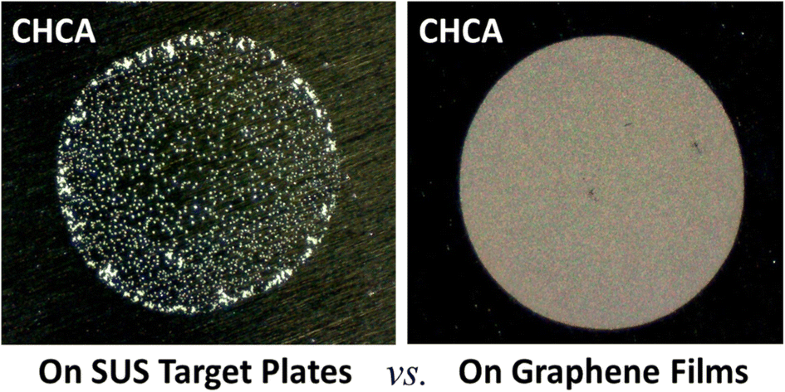Journal of the American Society for Mass Spectrometry ( IF 3.2 ) Pub Date : 2018-07-11 , DOI: 10.1007/s13361-018-2024-9 Yoon Kyung Choi 1 , Joo Yeon Oh 2 , Sang Yun Han 1
Due to the known sweet-spot issues that intrinsically arise from inhomogeneous formation of matrix-analyte crystals utilized as samples in matrix-assisted laser desorption ionization (MALDI) mass spectrometry, its reproducibility and thus its applications for quantification have been somewhat limited. In this paper, we report a simple strategy to improve the uniformity of matrix-analyte crystal spots, which we realized by adapting large-area graphene films, i.e., non-inert, interacting surfaces, as target surfaces. In this example, the graphitic surfaces of the graphene films interact with excess matrix molecules during the sample drying process, which induces spontaneous formation of optically uniform MALDI sample crystal layers on the film surfaces. Further, mass spectrometric imaging reveals that the visible uniformity is indeed accompanied by reproducible MALDI ionization over an entire sample spot, which greatly suppresses the appearance of sweet spots. The results of this study confirm that the proposed method achieves good linear responses of ion intensity to the analyte concentration (R2 > 0.99) with small relative standard deviations (σ < 10%), which is a range applicable for quantitative measurements using MALDI mass spectrometry.

ᅟ
中文翻译:

大面积石墨烯薄膜作为目标表面,适用于定量质谱的高度可再现的基质辅助激光解吸电离
由于已知的甜点问题本质上是由于基质辅助激光解吸电离(MALDI)质谱中用作样品的基质分析物晶体的不均匀形成而引起的,因此其可重复性及其定量应用受到了一定限制。在本文中,我们报告了一种提高基质分析物晶体斑点均匀性的简单策略,该策略是通过将大面积石墨烯薄膜(即非惰性,相互作用的表面)用作目标表面来实现的。在该示例中,石墨烯膜的石墨表面在样品干燥过程中与过量的基质分子相互作用,这导致在膜表面上自发形成光学均匀的MALDI样品晶体层。进一步,质谱成像显示,可见均匀性确实伴随着整个样品斑点上可重现的MALDI电离,这大大抑制了最佳斑点的出现。这项研究的结果证实了所提出的方法实现了离子强度对分析物浓度的良好线性响应(R 2 > 0.99),相对标准偏差小(σ <10%),该范围适用于使用MALDI质谱进行定量测量。

ᅟ



























 京公网安备 11010802027423号
京公网安备 11010802027423号